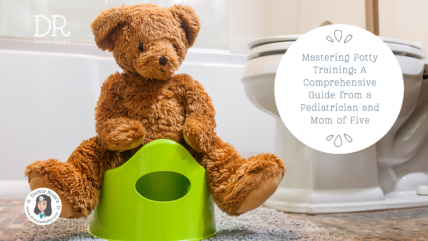As a pediatrician and a mother of five, I’ve experienced one of the most common challenges faced by parents: teaching children the concept of “no” while still fostering a positive and encouraging environment. It’s a delicate balance that requires patience, consistency, and empathy. Saying “no” is not about stifling curiosity or creativity; rather, it’s about setting boundaries to keep children safe and guide them towards responsible behavior. In this blog, I’ll share some insights and practical strategies on how to teach your little one “no” while maintaining a nurturing and encouraging approach.
Understanding the Developmental Stage: A Crucial Foundation

Before diving into teaching your child about boundaries, it’s crucial to understand their developmental stage. Young children are naturally curious and impulsive, exploring the world around them with boundless energy. They haven’t yet developed a full understanding of consequences or the ability to regulate their emotions effectively. Recognizing this helps parents set realistic expectations and respond with empathy.
Understanding the developmental stage of your child is essential because it shapes your approach to teaching boundaries. For instance, toddlers are at a stage where they’re testing their independence and asserting themselves. They may resist rules and boundaries as they strive to assert their autonomy. On the other hand, preschoolers are starting to grasp the concept of cause and effect but may still struggle with impulse control. By tailoring your approach to your child’s developmental stage, you can effectively teach them about boundaries in a way that’s developmentally appropriate and respectful.
Using Positive Language: The Power of Words

Instead of simply saying “no,” try to reframe your statements using positive language. For example, instead of saying, “No, you can’t climb on the table,” you could say, “Let’s find a safe place to play on the floor.” This approach provides clear guidance while also redirecting your child’s behavior in a more constructive manner.
Positive language not only helps to reinforce the desired behavior but also fosters a more encouraging and supportive environment. It communicates to your child that you’re on their side, guiding them towards better choices rather than simply shutting them down. Moreover, positive language helps to preserve your child’s self-esteem and confidence, preventing them from feeling discouraged or defeated.
Offering Alternatives: Empowering Your Child to Choose Wisely

Rather than focusing solely on what your child can’t do, provide them with alternative options. For instance, if they’re reaching for a fragile object, gently steer their attention towards a sturdier toy or activity. By offering alternatives, you’re teaching problem-solving skills and empowering your child to make better choices.
Offering alternatives not only helps to redirect your child’s behavior but also encourages them to think critically and creatively. It allows them to exercise their decision-making skills in a safe and supportive environment. Moreover, by involving your child in the decision-making process, you’re fostering a sense of autonomy and independence, which are essential for their overall development.
Setting Clear Expectations: Consistency is Key

Establishing clear expectations is essential for teaching boundaries. Consistency is key here. Make sure both parents and caregivers are on the same page regarding rules and consequences. Use simple language and repeat instructions as needed, reinforcing the message gently but firmly.
Consistency is crucial because it helps to provide a sense of predictability and stability for your child. When they know what to expect, they’re more likely to comply with the rules and boundaries you’ve set. Moreover, consistency helps to reinforce the message that certain behaviors are unacceptable, reducing confusion and frustration for both parents and children.
Modeling Positive Behavior: Leading by Example

Children learn by observing the actions of those around them, especially their parents. Model the behavior you wish to see in your child. If you expect them to say “please” and “thank you,” make sure you’re using those words consistently in your own interactions. By demonstrating respectful behavior, you’re laying the foundation for your child to follow suit.
Modeling positive behavior is essential because it provides your child with a tangible example to emulate. When they see you practicing patience, kindness, and respect in your interactions with others, they’re more likely to internalize those values and apply them in their own lives. Moreover, modeling positive behavior helps to create a positive and supportive family culture, where kindness and empathy are valued and encouraged.
Encouraging Communication: Fostering Openness and Trust

Create an open environment where your child feels comfortable expressing their thoughts and feelings. Encourage them to ask questions and share their concerns. When they understand that their voice is heard and valued, they’re more likely to respect the boundaries you’ve set.
Encouraging communication is essential because it strengthens the parent-child bond and fosters a sense of trust and security. When your child feels comfortable coming to you with their problems and concerns, they’re more likely to seek your guidance and support when faced with difficult situations. Moreover, open communication allows you to address any misunderstandings or conflicts promptly, preventing them from escalating into more significant issues.
Offering Praise and Encouragement: Celebrating Small Victories

When your child follows the rules or makes positive choices, be sure to acknowledge and praise their behavior. Positive reinforcement helps reinforce good habits and builds their confidence. Instead of focusing solely on what they’re doing wrong, highlight their efforts and progress.
Offering praise and encouragement is essential because it boosts your child’s self-esteem and motivates them to continue making positive choices. When they receive recognition for their efforts, they’re more likely to repeat those behaviors in the future. Moreover, praise and encouragement help to strengthen the parent-child bond, fostering a sense of connection and belonging within the family.
Using Natural Consequences: Learning Through Experience

Whenever possible, allow your child to experience the natural consequences of their actions. For example, if they refuse to wear a jacket on a chilly day, they might feel cold when they go outside. While it’s important to offer guidance and support, allowing them to learn from their experiences can be a powerful teaching tool.
Using natural consequences helps to reinforce the connection between actions and their outcomes. When your child experiences the consequences of their behavior firsthand, they’re more likely to internalize the lesson and think twice before repeating the same mistake. Moreover, natural consequences are often more effective than disciplinary measures because they’re directly related to the behavior in question, making them more meaningful and relevant to your child.
Staying Calm and Patient: The Power of Emotional Regulation

Teaching boundaries can be challenging, especially when faced with tantrums or resistance. It’s essential to remain calm and patient, even in the midst of frustration. Take a deep breath, and remember that your child is still learning and growing. Responding with empathy and understanding will ultimately strengthen your relationship and foster a positive learning environment.
Staying calm and patient is crucial because it sets a positive example for your child and helps to de-escalate tense situations. When you remain composed and collected, you’re better able to respond thoughtfully and effectively to your child’s needs. Moreover, staying calm and patient helps to preserve your child’s sense of security and trust, ensuring that they feel safe and supported even in challenging moments.
Seeking Support When Needed: Embracing the Village

Parenting is a journey filled with ups and downs, and it’s okay to ask for help when you need it. Whether it’s seeking advice from other parents, consulting with a pediatrician, or attending parenting classes, don’t hesitate to reach out
Teaching your little one “no” while maintaining an encouraging approach is possible with patience, consistency, and empathy. By understanding their developmental stage, using positive language, offering alternatives, and modeling positive behavior, you can help your child navigate boundaries in a nurturing environment. Remember to stay calm, praise their efforts, and seek support when needed. With time and practice, you’ll empower your child to make thoughtful choices and thrive in a loving and supportive family environment.











Leave a Reply
You must be logged in to post a comment.